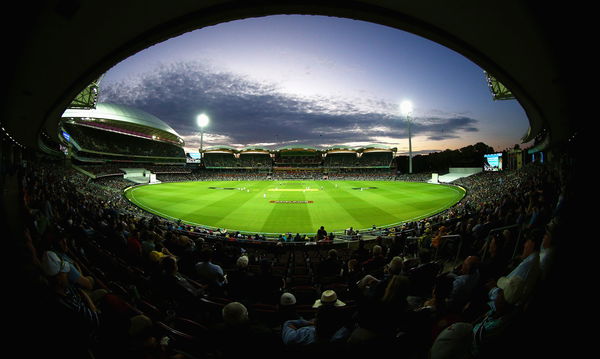
via Getty
Finally, the D/N sign will be seen next to matches. ©Getty Images

via Getty
Finally, the D/N sign will be seen next to matches. ©Getty Images
As another year comes to end, here is a look at the highlights of the best, worse and worst moments in cricket in the year 2015
The Good
The Minnows Ascend to the Top
ADVERTISEMENT
Article continues below this ad
It is always heartening to see the Davids outwit the Goliaths in any field not just sports. After an excruciating time in international cricket showing sparks of greatness here and there, 2015 was the Year of the Tiger with series wins over Pakistan and India apart from the World Cup Quarter Finish. For years, fans have seen Bangladesh win over Zimbabwe, Ireland and West Indies but somehow their flashes of potential have not resulted in the consistency that fans would like.
But 2015 was a different story. After beating Zimbabwe 5-0 at home, their World Cup Campaign began against Afghanistan (who had crushed them at Fatullah the previous year). Seeking to avenge the humiliating loss, Bangladesh not only beat Afghanistan comprehensively but also managed to beat England and entered the knockouts for the first time. While their World Cup Campaign ended on a sour note against India (remember the hue and cry over the waist above no-ball), Bangladesh bounced back and defeated arch rivals Pakistan at home, followed by crushing India and South Africa. After beating the three best teams all in one year, here’s hoping that 2016 sees Bangladesh establishes itself as a formidable opponent not just in ODIs and T20s but Tests as well !

via Imago
Mustafizur Rahman: The symbol of Bangladesh’s spectacular year. © AFP
Cricket in the USA
One of the biggest highlights of the year was the All Star tournament held in the USA which saw the biggest cricketing stars and legends playing together in efforts to publicize cricket in non-cricketing nations. For cricket fans, the sight of Shane Warne taking on Sachin Tendulkar, Sachin and Sehwag opening batting again, Shoaib Akhtar’s intimidating pace, Wasim Akram’s in swingers and Muttiah Murlitharan’s skill was a sign from God that prayers do get answered.
For the uninitiated, it was perhaps the greatest introduction to the sport from the best this sport has ever seen. The efforts may not bring fruit immediately but such initiatives are necessary for the survival of cricket with viewership numbers steadily but surely decreasing year-on-year. Here’s hoping that 2016 sees a lot more of such proactive and much-needed initiatives from ICC.

via Imago
Undoubtedly, the best moment of 2015 was watching the battle between the two greats. ©Rob Tringali/ESPN
Pink Ball and Day-night Test Cricket
With the introduction of T20 cricket, the fall of Test cricket was inevitable. A format beloved by cricketers and purists, the length of Test cricket meant that it could not find a place in the busy lives of the viewers it so desperately needs. A relic of the older times, when lives where not as stressful nor as full, test cricket needed to adapt to the 21 century.
Of all the various solutions suggested by ex-cricketers, administrators, journalists, commentators and fans, none but the implementation of day-night test matches had the widespread support. After years of just being an idea, day-night tests became a reality with the 3 test match between Australia and New Zealand on November 27, 2015 at Adelaide. With the feedback from players being extremely positive, the pink ball has given test cricket a new lease of life.

via Getty
Finally, the D/N sign will be seen next to matches. ©Getty Images
The Bad –
Ashes of Babylon
The fall of the West Indian cricket from the glittering heights it reached in the 80s reached a new low in 2015. Clive Lloyd’s intimidating team is still talked about with a kind of reverence that is hard to find across different sports. On September 30, West Indian cricket stooped to a new low, one whose stain will be hard to erase. The current team failed to qualify for the Champions Trophy.
The decline has been dramatic, to quote an article in the Economist, “Statistics highlight how dramatic the West Indies’ decline has been. Between March 1976 and March 1995, the West Indies won 71 and lost only 20 Test matches against the other eight Test-playing nations (excluding Zimbabwe, which did not gain Test status until 1992).Since June 2000 the side has won 14 and lost 78 Tests against the same opponents. “
The relations between the West Indies Players Association and West Indies Cricket Broad (WICB) along with economic woes have been the main reasons for the collapse. In fact, both reasons are interlinked with the disputes between the two bodies being economic woes. Over the years, there have been numerous altercations between the players and the board usually over pay and other contractual issues. With lucrative T20 leagues being developed all over the world, various West Indian players now prefer such leagues to their international commitments. As a result weaker teams are fielded and viewers further decrease further exacerbating the board’s economic woes.

via Getty
Once upon a time, this picture would have given the opposition side nightmares, now a pale shadow of its former glory. ©Getty Images
Yasir Shah Doping Scandal
Yasir Shah was one of the breakout stars of 2015, ending at the 3position in the Best Test Bowlers Rankings. Shah has so far taken 76 wickets in 12 Tests and became the fastest to complete 50 wickets in nine Tests — a record for Pakistan. Which is why, him testing positive for doping is sad news for Pakistan. The ICC in its statement released on 27 December said, “The test, conducted on 13 November 2015, was found to contain the presence of chlortalidone, a Prohibited Substance which appears in Section 5 of the World Anti-Doping Agency list (in the category of Specified Substances).
In accordance with the ICC Anti-Doping Code, pending the outcome of the disciplinary process, Yasir has been provisionally suspended”. Yasir Shah has seven days to contest the decision and submit his sample again and if tested negative then the ban will be lifted with immediate effect, if however, it tests positive, he could face a ban from all cricket activities for up to four years. With the T20 World Cup just months away, such an incident is the last thing the Pakistani campaign needs.

via Getty
The Messi look-alike player ended a great year with one of the most challenging setbacks in the life of a sportsman. © Getty Images
The Ugly –
IPL Fiasco
The IPL made the headlines in 2015 for all the wrong reasons. Considered to be one of the biggest cricketing events, it has seen its fair share of controversies but the banning of the two most popular and successful franchises by the Lodha Committee was undoubtedly the lowest point of 2015 for every cricket fan not just those in India. The controversy surrounding IPL also saw the exit of the title sponsors PepsiCo two years ahead of schedule.
While the quality of cricket that Chennai Super Kings and Rajasthan Royals produced was in many cases superior to that of many international teams but as the owners discovered, actions have consequences and in this case, unfortunately their actions resulted in the expulsion of Rajastan Royals and Chennai Superkings. The fireworks are not yet over as the Lodha Committee is set to present its view on Indian cricket to the Supreme Court in the first week of 2016.
ADVERTISEMENT
Article continues below this ad

via Imago
RM Lodha : the person tasked with rooting out corruption from the IPL. 2016 is going to be a challenging year for the T20 league. © AFP
No room for Associates
ADVERTISEMENT
Article continues below this ad
In 2014, amidst allegations of corruption, N Srinivasan changed the face the top body in cricket functions. The ICC, was international in all but name, as the three most powerful nations – India, Australia and England – took complete control of the reins of the ICC. The trend was worrisome especially for Associate nations like USA, Scotland, Ireland and Namibia whose boards had been surviving on the lifeline extended to them by the ICC in the greater interest of the sport. However, the most alarming decision that was taken this year was reducing the number of sides from 14 in the 2015 World Cup to just 10 in the 2019 World Cup, essentially, excluding the Associates from the 2019 World Cup.
This is a shocking decision as the only way to promote cricket in Associate nations is through exposure such as that provided by a tournament like the World Cup. The Associates also enhance the suspense of a World Cup as can be seen by the stupendous performance of Ireland in 2007 World Cup or that of Kenya in the 2003 World Cup. The decision is a travesty. At a time when the number of nations playing cricket is reducing, the decision to limit the number of sides, taken purely from the advertiser’s perspective, raises questions on whether the apex body values has the best interests of the game in heart when making decisions or just looks at the commercial implications of the World Cup.
ADVERTISEMENT
ADVERTISEMENT
ADVERTISEMENT
ADVERTISEMENT

